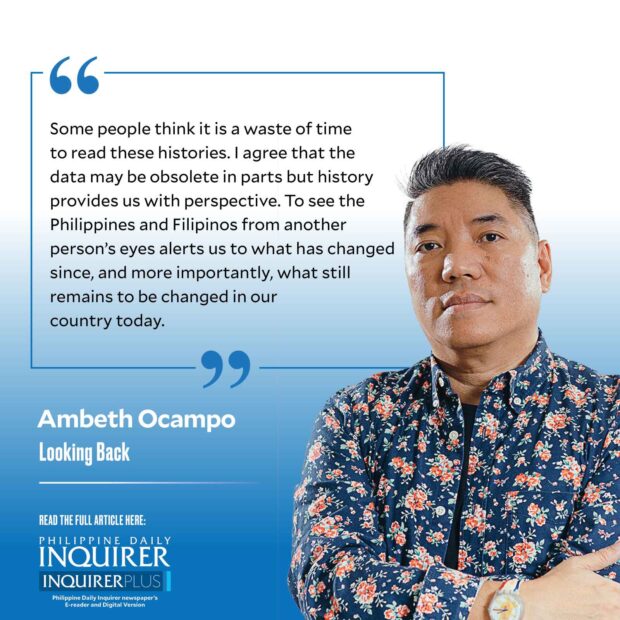French under our skin

That Filipinos are separated from their past because of language, is not just about Spanish and the primary sources on the Spanish colonial period (1565-1898); this also covers books and manuscripts from the same period locked in other languages like French, Italian, German, Dutch, Japanese, and Chinese. I learned about French sources in the 1980s while hunting down Filipiniana in Paris, both at the great Porte de Clignancourt flea market and the “bouquinistes” or used book sellers that lined the banks of the river Seine. Centuries-old books, maps, prints, and even postcards on the Philippines could be had cheaply at the time. In retrospect, I should’ve focused on art rather than printed material. At the time works by: Juan Luna, Félix Resurrección Hidalgo, Felix Pardo de Tavera, and other 19th-century Filipino artists appeared in the Paris antique market to those who had more luck and funding than me.
What guided my book-hunting were literally within arms-reach from the living room couch of Marc and Ofelia Tequi in Paris. I crashed here many times in the 1980s and when everyone had retired to the bedrooms, I had full access to the enviable collection of Filipiniana patiently gathered by Mr. Tequi over many years. It was here that I acquainted myself with 19th-century standard works: Gironière, Marche, Montano, Plauchut, Turot, and many more.
Paul P. de la Gironière, (1797-1862) spent enough time in the islands to become the self-proclaimed “Lord of Jala-jala.” He is best known for travelogues translated from the original French into English: “Twenty Years in the Philippines” (1854), “Adventures of a Breton Gentleman in the Philippine Islands” (1855), and “Indian customs and some philosophical thoughts during a voyage to Majaijai” (1862). His account reads like a swashbuckling adventure in parts exaggerated or embellished, but it is the setting of his stories that has historical value.
More serious French travelers were: Joseph Montano who published “Voyage to the Philippines and Malaysia” (1886), Antoine-Alfred Marche (1844-1898,) who published “Luzon and Palawan: Six years voyage in the Philippines” (1887) with illustrations of prehistoric artifacts and gold jewelry excavated during his expedition that are now in the Musée de l’Homme; Henri Turot (1865-1920) was a journalist who covered the Philippine-American War, his reportage sympathetic to the Filipinos and the Filipino struggle for independence appeared in the magazine Le Tour du Monde (1899) followed by the book “Aguinaldo and the Filipinos” (1900).
It comes as a surprise to many Filipinos that the flowering plant known locally as “bongavilla” or “bonganvilla” were first described by botanists in the 18th-century French expedition that circumnavigated the world under Louis Antoine de Bougainville. Or that the dessert banana we know as “latundan” is referenced by another Frenchman named Le Tondale. What other Philippines-French historical connections remain to be found? If we are to look at books in French on the 19th-century Philippines, you will discover works that are not by Frenchmen but by Belgians, like two published in translation by the National Historical Commission: one was by Pierre Joseph Lannoy, the Belgian Consul in Manila from 1837 to 1847, who published “The Philippines and their situation past and present” in Brussels in 1849.
Then there is J. de Man, “Recollections of a voyage to the Philippines,” an obscure work published in Antwerp in 1875, that, being a travelogue, contains many curious observations written for readers who probably did not know where the Philippines was. De Man describes earthquakes, locust infestations, fish that live on land (dalag or mudfish), duck-hunting, and many other things that seem quaint to readers in 2024. Even his descriptions of places he visited seem beyond our imagination. For example, he declared, “Laguna is to Luzon what Switzerland is to Europe; that is to say, it is the picturesque portion of the island.”
He described a visit to Laguna where he was dropped off at the end of the Pasig River and picked up 15 days later at the same spot for a return trip to Manila. There were no hotels or inns at the time so one camped out where night reached them, but all this inconvenience is nothing to someone who describes the landscape in a very romantic way. I noted that their provisions for the two-week trip consisted of: two big Lyon sausages, two tins of sardines, one bottle of cognac, and two bottles of sherry. The rest of the meals were to be sourced along the way. In their luggage were a shotgun and a revolver, “anything more would have been superfluous encumbrance in a region where one puts on the least possible clothing.”
I cannot recognize the Philippines of the 19th century in these travel accounts, except for descriptions of people and their customs that are still visible from my perch in 2024. Some people think it is a waste of time to read these histories. I agree that the data may be obsolete in parts but history provides us with perspective. To see the Philippines and Filipinos from another person’s eyes alerts us to what has changed since, and more importantly, what still remains to be changed in our country today.
—————-
Comments are welcome at aocampo@ateneo.edu
















